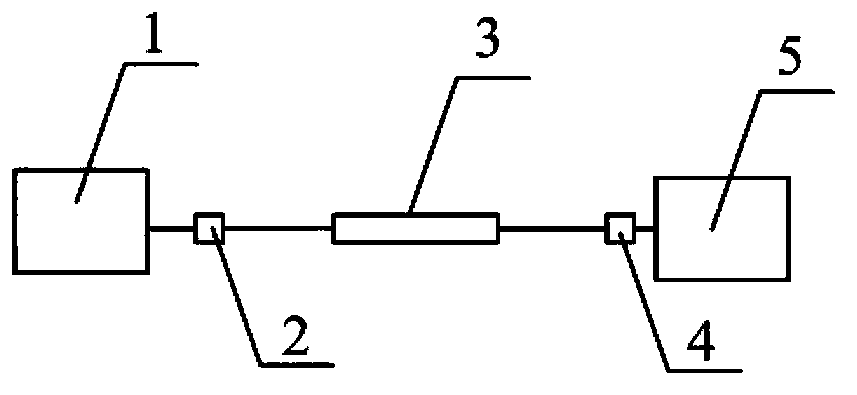Detection device of chloride in drinking water
A detection device, chloride technology, applied in the direction of phase influence characteristics measurement, etc., can solve the problems of high requirements for the use environment, high requirements for spectral inversion, slow analysis speed, etc., and achieve low loss, strong resistance to harsh environments, and preparation The effect of simple process
- Summary
- Abstract
- Description
- Claims
- Application Information
AI Technical Summary
Problems solved by technology
Method used
Image
Examples
Embodiment 1
[0017] exist figure 1 In the schematic diagram of the drinking water chloride detection device shown, the light source is a broadband light source 1 with a central wavelength of 1550nm connected to one end of the biconical photonic crystal fiber sensor 3 through the first optical fiber connector 2, and the other end of the biconical photonic crystal fiber sensor Connect with the near-infrared spectrum analyzer 5 through the second optical fiber connector 4; figure 2 As shown, the above-mentioned biconical photonic crystal fiber sensor is formed by melting and tapering the optical fiber to change the structure of the core and the cladding. Single-mode optical fiber 8 constitutes.
Embodiment 2
[0019] A broadband light source with a central wavelength of 850nm is connected to one end of the biconical photonic crystal fiber drinking water chloride sensor through the first optical fiber connector, and the other end of the biconical photonic crystal fiber drinking water chloride sensor is connected to the drinking water chloride sensor through the second optical fiber connector. The connection of the near-infrared spectrum analyzer; the above-mentioned biconical photonic crystal fiber drinking water chloride sensor is a 235mm long biconical photonic crystal fiber formed by changing the structure of the core and the cladding through the fusion of the optical fiber. A single-mode fiber and a second single-mode fiber are formed. Such as image 3 As shown, the interference fringes are smooth, and the contrast of the interference signal is 3.54dB.
Embodiment 3
[0021] The light source is a broadband light source with a central wavelength of 2400nm, which is connected to one end of the biconical photonic crystal fiber drinking water chloride sensor through the first optical fiber connector, and the other end of the biconical photonic crystal fiber drinking water chloride sensor is connected to the drinking water chloride sensor through the second fiber optic connector. The near-infrared spectrum analyzer is connected; the above-mentioned biconical photonic crystal fiber drinking water chloride sensor is formed by melting and tapering the optical fiber to change the structure of the core and the cladding. A single-mode fiber and a second single-mode fiber are formed.
[0022] The light emitted by the light source enters the biconical photonic crystal fiber sensor, and the biconical photonic crystal fiber sensor is placed in the drinking water to be measured and surrounded by the drinking water to be measured. The light is split at the ...
PUM
| Property | Measurement | Unit |
|---|---|---|
| length | aaaaa | aaaaa |
| length | aaaaa | aaaaa |
| length | aaaaa | aaaaa |
Abstract
Description
Claims
Application Information
 Login to View More
Login to View More - R&D
- Intellectual Property
- Life Sciences
- Materials
- Tech Scout
- Unparalleled Data Quality
- Higher Quality Content
- 60% Fewer Hallucinations
Browse by: Latest US Patents, China's latest patents, Technical Efficacy Thesaurus, Application Domain, Technology Topic, Popular Technical Reports.
© 2025 PatSnap. All rights reserved.Legal|Privacy policy|Modern Slavery Act Transparency Statement|Sitemap|About US| Contact US: help@patsnap.com



